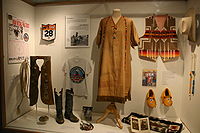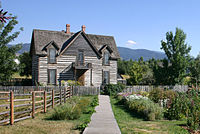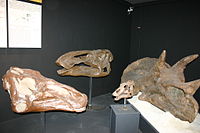- Museum of the Rockies
-
Coordinates: 45°39′53″N 111°2′59″W / 45.66472°N 111.04972°W
Museum of the Rockies Established 1957 Location 600 W. Kagy Boulevard, Bozeman, Montana, USA Type Natural History Museum Director Montana State University in Bozeman, Smithsonian Institution Curator Jack Horner Website Museum of the Rockies The Museum of the Rockies, is located in Bozeman, Montana. The museum, originally affiliated with Montana State University in Bozeman, and now, also the Smithsonian Institution, is known for its paleontological collections, although these are not its sole focus. The Museum of the Rockies houses the largest collection of dinosaur remains in the United States, possessing the largest Tyrannosaurus skull ever discovered, as well as the thigh bone of a Tyrannosaurus rex that contains soft-tissue remains.[1] The museum is part of the Montana Dinosaur Trail and is Montana's official repository for paleontological specimens.
The museum's collections focus on the physical and cultural history of the Rocky Mountains and the people and animals who have lived there, and date back more than 500 million years. Permanent exhibits include: Enduring Peoples, which chronicles the life of American Indians on the Northern Plains and near the Rocky Mountains; History of the Northern Rocky Mountain Region, whose inhabitants included Native Americans, fur traders, gold seekers, and white settlers from frontier days through World War II; Living History Farm, which includes the Tinsley House, where costumed interpreters demonstrate life in a turn-of-the-century home; and the Taylor Planetarium, a 40 ft (12 m), 104-seat domed theater.
Contents
Overview
The Museum of the Rockies preserves and tells the stories of Montana and the Northern Rockies; educating visitors about the region's rich history, which includes its paleontological roots.[2] The museum was founded in 1957, funded in part by a gift from Caroline McGill. The museum's collections have grown to include 300,000 objects that cover more than 500,000,000 years of history. In 1980, the museum acquired over 10,000 photographs and negatives from the heirs of Albert, Alfred and Chris Schlechten (now known as the Schlechten collection). These photographs chronicle the Bozeman and Yellowstone National Park areas over two generations (from about 1905 until the late 1970s).[3]
The museum offers symposiums allowing Native Americans whose tribes called the region home, to share their oral histories with visitors.[4] In 2005, the Museum became an affiliate of the Smithsonian Institution, which provided the museum greater access to the collections and programs of that institute.[5]
Traveling exhibits that visit the museum have covered topics as diverse as African American art,[6] television and film costumes,[7] the impact of weapons on the cultures of the Rocky Mountains,[8] and King Tut.[9]
Tinsley House
The Tinsley House is preserved by the Museum of the Rockies as a living history museum. The 100+ year-old house was originally located in Willow Creek and it was moved to its present site (on more than 10 acres (40,000 m2)) behind the museum in 1989. At the museum, visitors can learn about the life of the Tinsleys and others who lived at the time. Children can try on clothes and play with contemporary toys of the time. The house includes a functioning outhouse, water pump[10] and kitchen where food typical of the time is sometimes prepared.[11]
Background
The Tinsleys migrated west during the American Civil War. William and Lucy [Nave] Tinsley met in Virginia City, Montana, where both worked. They relocated to the Gallatin Valley after they married. The Tinsleys built their house in 1889 when the original cabin became too small to accommodate their growing family. The house provides an overview of homestead life in the 1800s in the Gallatin Valley. The house was constructed of logs accumulated over the course of two years from the Tobacco Root Mountains. Many of the interior items are believed to have been ordered from the Sears catalog.[10] Most items in the house have been donated by Tinsley descendants.
Paleontology
While not its sole focus, the museum is primarily known for its paleontological collections. This was not always the case, however. Specimens found in Montana had usually been taken out of state to other museums. This changed in 1990 with the discovery of a Tyrannosaurus rex skeleton that would remain in Montana and be exhibited at the museum.[12]
While fossils continue to be property of the federal government, the museum has been able to increase its collection (due in part to Curator Jack Horner's agreement and work with the United States Fish and Wildlife Service and the federal Bureau of Land Management).[13] The museum is now home to twelve Tyrannosaurus rex specimens, including one of only two complete that have ever been found.[14]
Apart from housing one of the largest collections of dinosaur fossils in the world and the largest in the United States,[15] the museum is also home to the world's largest Tyrannosaurus skull –narrowly beating out that of the Chicago Field Museum's center-piece, main rotunda display, Sue.[16] The museum's Siebel Dinosaur Complex, designed by curator Horner, is home to one of the first identified female dinosaurs, an ovulating T. rex.[1] Curator Horner, who served as adviser to the Jurassic Park films,[15][17] was one of the lead scientists involved in the 2005 discovery of soft tissue remains in the thigh bone of a Tyrannosaurus,[18] which were later brought to the museum. The museum has also been involved in a number of other finds, including a baby Triceratops in Jordan, Montana, in 2006.[19]
In June 2008, the museum formed part of a consortium that obtained a mobile paleontology lab that would assist researchers, allowing them to chemically analyze fossils while still in the field in order to help prevent degradation.[20]
References
- ^ a b "Take the State's Dinosaur Trail". Great Falls Tribune. 2008-06-02. http://www.greatfallstribune.com/apps/pbcs.dll/article?AID=/20080602/NEWS01/806020305/1002. Retrieved 2008-06-12.[dead link]
- ^ William F. Allman (1993-06-17). "The Real Jurassic Park Lies in Montana". U.S. News and World Report. http://nl.newsbank.com/nl-search/we/Archives?p_product=RM&p_theme=rm&p_action=search&p_maxdocs=200&p_topdoc=1&p_text_direct-0=0EB4DCB277C96CAC&p_field_direct-0=document_id&p_perpage=10&p_sort=YMD_date:D&s_trackval=GooglePM. Retrieved 2008-06-12.
- ^ {[cite web|url=http://muse.museum.montana.edu/photoarc/info/schlechten-info.html |title=Photo Archives |publisher= Museum of the Rockies|accessdate=2011=08-10}}
- ^ "Montana Tribes to Share Living Histories at Montana State University". 2008-03-21. http://www.highbeam.com/doc/1P3-1452228951.html. Retrieved 2008-06-12.
- ^ "Museum of the Rockies to Become Smithsonian Affiliate". Helena Independent Record. 2005-08-06. http://www.helenair.com/articles/2005/08/06/montana/a10080605_01.txt. Retrieved 2008-06-12.
- ^ "Paul R. Jones Exhibit at Montana State". 2006-02-28. http://www.highbeam.com/doc/1P3-1158279661.html. Retrieved 2008-06-12.
- ^ "Costume Display at Bozeman Museum". Montana's News Station. 2008-06-11. http://www.montanasnewsstation.com/Global/story.asp?S=8463496&nav=menu227_3. Retrieved 2008-06-12.
- ^ Ron Franscell (2001-06-03). "Tools of War Create Lessons of Survival". The Denver Post. http://nl.newsbank.com/nl-search/we/Archives?p_product=DP&p_theme=dp&p_action=search&p_maxdocs=200&p_topdoc=1&p_text_direct-0=0EC6FF403A204582&p_field_direct-0=document_id&p_perpage=10&p_sort=YMD_date:D&s_trackval=GooglePM. Retrieved 2008-06-12.
- ^ Rob Chaney. "Tut Exhibit Injects New Life". The Missoulian. http://www.missoulian.com/articles/2007/05/14/outdoors/out80.txt. Retrieved 2008-06-12.
- ^ a b Chaundera Wolfe. "The Tinsley House". Outside Bozeman. http://www.outsidebozeman.com/magazine.php?action=fullArticle&articleID=299. Retrieved 2008-06-12.
- ^ "Living History". The Deseret News. 2002-09-22. http://nl.newsbank.com/nl-search/we/Archives?p_product=NewsLibrary&p_multi=DSNB&d_place=DSNB&p_theme=newslibrary2&p_action=search&p_maxdocs=200&p_topdoc=1&p_text_direct-0=0F6390D6513C6B75&p_field_direct-0=document_id&p_perpage=10&p_sort=YMD_date:D&s_trackval=GooglePM. Retrieved 2008-06-12.
- ^ "Montana's Bone Bonanza; Tyrannosaurus Rex Skeleton to Remain in the State". The Washington Post. 1990-08-28. http://www.highbeam.com/doc/1P2-1144672.html. Retrieved 2008-06-12.
- ^ "Theories Evolve in T. Rex Discoveries". The New York Times. 2000-12-26. http://query.nytimes.com/gst/fullpage.html?res=9503EED61238F935A15751C1A9669C8B63. Retrieved 2008-06-12.
- ^ Peggy Mihelich (2007-03-08). "Jack Horner Knows his Dinosaurs". CNN. http://www.cnn.com/2006/TECH/science/08/25/dino.profile/index.html. Retrieved 2008-06-12.
- ^ a b Claire Walter (2008-05-20). "'Dinosaur Highway' Rich in Dig Sites, Museums". The Dallas Morning News. http://www.dallasnews.com/sharedcontent/dws/fea/travel/thisweek/stories/DN-dino_0518tra.ART.State.Edition1.1f64fa4.html. Retrieved 2008-06-12.
- ^ Andrew Herrmann (2006-04-12). "Head to Head, new T. Rex Beats Field's Museum's Sue". Chicago Sun-Times. http://www.highbeam.com/doc/1P2-1623702.html. Retrieved 2008-06-12.
- ^ Susan Gallagher (1993-11-21). "Maverick Dinosaur Expert Gets in His Digs in Montana Fossils". The Los Angeles Times. http://pqasb.pqarchiver.com/latimes/access/60257201.html?dids=60257201:60257201&FMT=ABS&FMTS=ABS:FT&date=Nov+21%2C+1993&author=SUSAN+GALLAGHER&pub=Los+Angeles+Times+(pre-1997+Fulltext)&desc=Maverick+Dinosaur+Expert+Gets+in+His+Digs+in+Montana+Fossils%3A+Jack+Horner+was+the+inspiration+for+%60Jurassic+Park.'+The+top+paleontologist+is+also+a+dyslexic+college+dropout.&pqatl=google. Retrieved 2008-06-12.
- ^ Guy Gugliotta (2005-03-25). "A Major T. Rex Breakthrough". The Washington Post. http://www.washingtonpost.com/ac2/wp-dyn/A63318-2005Mar24?language=printer. Retrieved 2008-06-12.
- ^ "Baby Triceratops Found by Museum of the Rockies Researchers". 2006-07-21. http://www.highbeam.com/doc/1P3-1110360421.html. Retrieved 2008-06-12.
- ^ "New Mobile Paleontology Lab Begins Work". UPI. 2008-06-11. http://www.upi.com/Science_News/2008/06/11/New_mobile_paleontology_lab_begins_work/UPI-31301213200449/. Retrieved 2008-06-12.
External links
 Media related to Museum of the Rockies at Wikimedia Commons
Media related to Museum of the Rockies at Wikimedia Commons State of Montana
State of MontanaHelena (capital) Topics Index · History · Governors · People · Geography · State Government · Delegations · Visitor Attractions
Society Crime · Demographics · Economy · Education · Politics
Regions The Flathead · Glacier National Park · Regional designations of Montana · Western Montana · Yellowstone
Largest cities Counties Beaverhead · Big Horn · Blaine · Broadwater · Carbon · Carter · Cascade · Chouteau · Custer · Daniels · Dawson · Deer Lodge · Fallon · Fergus · Flathead · Gallatin · Garfield · Glacier · Golden Valley · Granite · Hill · Jefferson · Judith Basin · Lake · Lewis and Clark · Liberty · Lincoln · Madison · McCone · Meagher · Mineral · Missoula · Musselshell · Park · Petroleum · Phillips · Pondera · Powder River · Powell · Prairie · Ravalli · Richland · Roosevelt · Rosebud · Sanders · Sheridan · Silver Bow · Stillwater · Sweet Grass · Teton · Toole · Treasure · Valley · Wheatland · Wibaux · Yellowstone
Categories:- History museums in Montana
- Living museums in Montana
- Montana State University – Bozeman
- Institutions accredited by the American Association of Museums
- Museums in Bozeman, Montana
- Native American museums in Montana
- Natural history museums in Montana
- Planetaria in the United States
- University museums in Montana
- Dinosaur museums in the United States
- Smithsonian Institution affiliates
Wikimedia Foundation. 2010.





